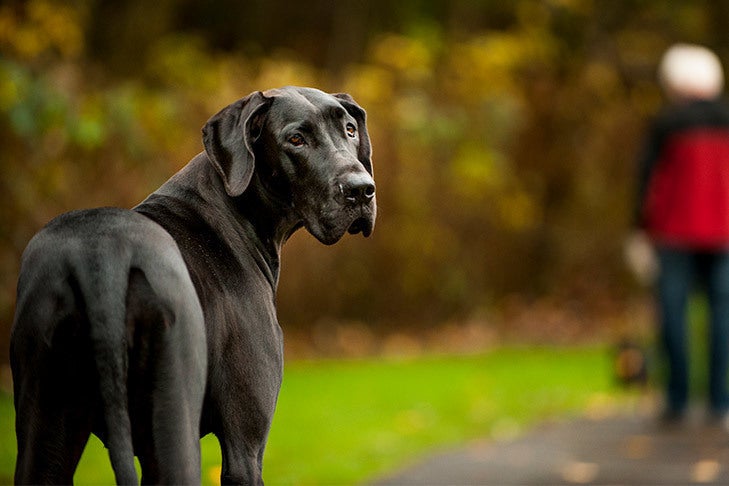The most common cause of canine rear-end lameness in puppies is hip dysplasia, a degenerative disease that affects the hip joints and progresses over time. Large breeds like German Shepherd dogs, Saint Bernards, and Greater Swiss Mountain dogs are the ones most frequently affected by canine hip dysplasia, but dogs of any size and both sexes can be affected.
The cause of canine hip dysplasia isnt known. Hip dysplasia is thought to have a genetic component, so breeding should be avoided by owners of these dogs. Hip dysplasia is more likely to affect puppies born to parents with the condition than puppies born to parents with healthy hips. However, even dogs with normal parents can develop hip dysplasia.
What Causes Hip Dysplasia in Dogs?
Hip dysplasia in dogs is brought on by a number of factors, starting with genetics. Greater breeds of dogs, such as the Great Dane, Saint Bernard, Labrador Retriever, and German Shepherd Dog, are more likely to develop hip dysplasia because it runs in their families. This genetic predisposition can be amplified by elements like an excessive growth rate, certain types of exercise, an improper weight, and an unbalanced diet.

Some puppies need food that is specifically formulated for large-breed puppies because they have unique nutritional needs. These foods aid in preventing rapid growth, which can cause joint and skeletal conditions like elbow dysplasia and hip dysplasia. By limiting these breeds’ growth, their joints can develop without being overextended, reducing the risk of future issues.
Giving a dog too much or too little exercise can both increase or decrease their chance of developing hip dysplasia. Obesity places a great deal of stress on your dog’s joints, which can worsen or even cause conditions like hip dysplasia. Consult your veterinarian for advice on the best diet for your dog and how much exercise they should get each day to maintain good health.
How do dogs get hip dysplasia?
Understanding the fundamental anatomy of a hip will help you comprehend how dogs develop hip dysplasia. The hip is a ball and socket joint. The ball (the top of the thigh bone) and the socket (a pocket in the pelvis) of a puppy must develop at the same rate. This uniform growth does not take place in canines with hip dysplasia, leading to improper ball-and-socket alignment or underdeveloped pelvic muscles.
Despite the fact that hip dysplasia in dogs is a hereditary condition, environmental factors have a significant impact on the likelihood of a dog developing the condition. Some of these include:
As you can see, it’s crucial to pay attention to your dog’s developing joints. Feeding them a proper diet is essential, especially during their first year of life, and it’s best to postpone any surgery or vigorous exercise until they are adults.
Signs and Symptoms of Hip Dysplasia
Dogs with hip dysplasia may experience problems getting up, climbing stairs, jumping, or engaging in other physical activities. They might also exhibit a decrease in activity or become lethargic. Dogs with hip dysplasia frequently walk with a narrow “bunny-hopping” gait, and when they exercise, you might hear grating noises coming from their hip region. Additionally possible symptoms include pain, joint heaviness, lameness, and muscle loss. Consult with a vet as soon as possible if you think your dog may be displaying symptoms of canine hip dysplasia.
FAQ
Can you tell if a dog has hip dysplasia by the way they walk?
When they walk, dogs with hip dysplasia may sway back and forth. Additionally, they might walk with a bunny hop or stand with their feet together. These potential gait issues are all connected to the discomfort that people with hip dysplasia experience.
How long can a dog live with hip dysplasia?
Hip dysplasia shouldn’t drastically shorten your dog’s life; it should only affect how long they can live. Any dog with the condition should live a full and active life as long as it receives treatment and is well cared for at home.
How do I know if my dog had hip dysplasia?
- Decreased activity.
- Decreased range of motion.
- Difficulty or reluctance rising, jumping, running, or climbing stairs.
- Lameness in the hind end.
- Swaying, “bunny hopping” gait.
- Grating in the joint during movement.
- Loss of thigh muscle mass.
Can dog hip dysplasia heal on its own?
There is no cure for hip dysplasia in dogs. However, there are numerous therapies that have shown promise in relieving pain in older dogs and halting further damage in young puppies. Maintain a healthy diet and exercise routine as the most fundamental treatments.